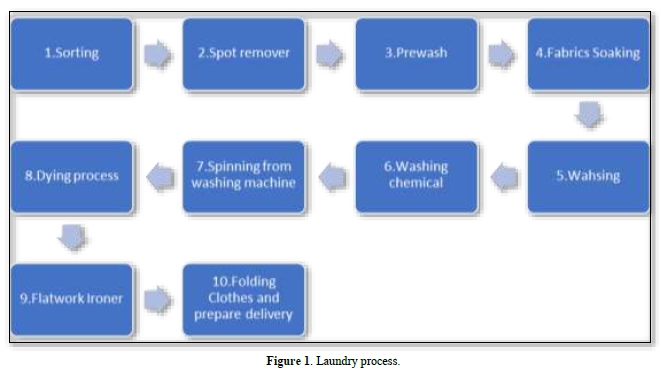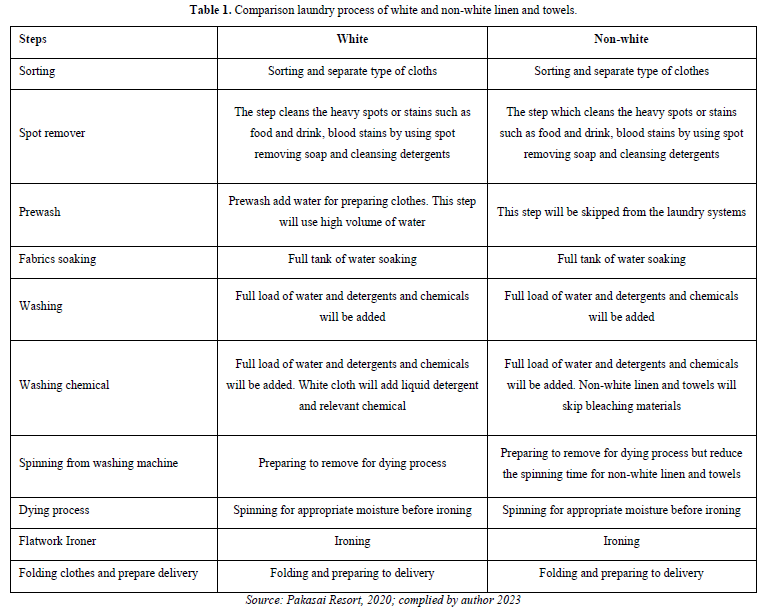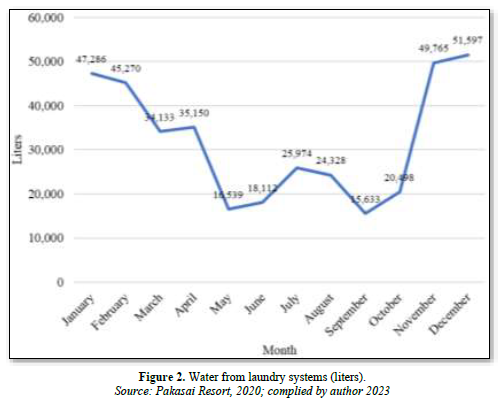-
Publish Your Research/Review Articles in our High Quality Journal for just USD $99*+Taxes( *T&C Apply)
Offer Ends On
Antika Sriraksa, Tanawan Sintunawa and Amphai Wejwithan*
Corresponding Author: Amphai Wejwithan, Director of the Green Leaf Foundation, Thailand.
Received: November 17, 2023 ; Revised: December 04, 2023 ; Accepted: December 07, 2023 ; Available Online: January 04, 2024
Citation:
Copyrights:
Views & Citations
Likes & Shares
Results of the case study found that there are differences between before and after of changing from white to the non-white linen and towels of the Pakasai Resort. The laundry could reduce water 384,282 liters in 2019, electricity reduced 47,805-kilowatt- hours, and total emission reduced from water and electricity consumption was 24,007 kilograms of carbon dioxide equivalent. Therefore, it can be concluded that using non-white linen and towels instead of white in hotel rooms, whether it be bedsheets, pillowcases, towels, or cloth used for other purposes, results in the use of water and electricity resources as well as the release of greenhouse gases.
Keywords: Green leaf standard, Water consumption, Energy consumption, Carbon emissions, Green laundry
INTRODUCTION
Hotel and accommodation provide food, drinks, comfort, and promote for living or staying in rooms that are clean. Cleaning clothes meet standard and hygiene is considered extremely important. It has been found that in the laundry process of the industry or hotel business consumes high volume of water and energy, which leads to carbon dioxide emission. A deficiency is one of the key factors that needs to be compensated by hotel laundry system. Therefore, Green Leaf Standard, a sustainability standard for hotel in Thailand, is trying to promote hotel to use unbleached and undyed and non-white linen and towels or so call environmentally friendly products. The Green Leaf Standard is designed to help lower operational costs and pass those cost-savings on to the customers, in the end of supply chain. Indeed, the program also encourages participatory activities by customers in energy saving and natural resources conservation. The Green Leaf Foundation has confidence in the efforts of hotel owners, operators, and their business partners in working collaboratively towards the betterment in managing the environmentally quality for the prosperity and sustainability of the industry and the country [1]. In this study, data were collected, and interviews were conducted with Five Leaves Hotel, the Pakasai Resort, the Green Leaf Foundation ‘s member. The hotel business is used variety of resources. Water and energy are considered as primary resources to run the hotel business. Energy and water consumption are not only a use of resources but also an indication of the release of greenhouse gasses hotel operations and services. This study is a comparative study of case studies between hotel strategies for using linen and towels in guest rooms by changing from white and synthetic fiber to natural fiber and non-white linen and towels. It compares by washing processes within term of water and energy consumption, which ultimately leads to the release of greenhouse gases into the atmosphere.
WATER
Water used for laundry cause a significant of a hotel’s overall water footprint. Laundry has been a very high-profile item in hotels’ environmental impacts activities for years and most hotels encourage their guests to re-use towels during their stay. However, many hotels use outsources some or all their laundry activities. Water withdrawal from outsource laundry operations should be included in a hotel’s overall footprint to assist with the comparability of different hotels’ overall footprints. Laundry undertaken internally is captured within the methodology. Water used by outsourced laundry should be included in the hotel’s water footprint as this case study. The statistic of water consumption from laundry system found that the laundry supplier may be able to provide the amount of water used. Where the total water used is not available from the supplier, the total water can be calculated based on an assumption that 20,000 liters of water is used to wash 1 ton of laundry; if the total tonnage of laundry is unknown, it can be estimated based on an assumption of 0.00512 tones (or 0.0056 imperial tons) of laundry per occupied room [2]. The calculation for outsourced laundry is as follows:
ENERGY
Energy consumption of laundry system comes from the operation of washing machines and dryers, and this includes boilers, of the laundry. Ensure that the water temperature and amount of water used are in accordance with the washing. The Hotel energy solution mentions almost all the solutions dealing with energy management and some solutions dealing with equipment regulation and with the replacement of electrical equipment of the laundry [4]. Laundry is a major consumer energy in hotel. Between electricity and hot water, a washer and dryer can account to hotel energy consumption. The outsource laundry can account for total energy consumption and the total emissions that emitted by hotel laundry activities. The energy benchmark from laundry system is relevant to type of fabrics, non-white linen and towels as well as the weight. Accounting to this case study assumes from time spending from overall laundry systems. In the end of the case study, hotel had calculated the footprint from water and energy reduction by changing non-white linen and towels from hotel rooms.
CHEMICAL
Laundry processes, in addition to the use of energy and water, it also causes environmental impacts, especially water contamination and the release of chlorine-contaminated water or detergents into natural water sources, which causes adverse effects on living things, especially aquatic life. The problem of chlorine and detergent contamination of water resulting from hotel laundry processes can have adverse effects on aquatic, marine and coastal ecosystems, as can be seen from many examples with related assumptions. The contamination of water released from laundry systems into natural water sources, such as the Algie Bloom phenomenon, impacts on small organisms such as planktons disappear from coastal ecosystems, etc. Sodium and calcium hypochlorite can cause irritation of the eyes, skin, respiratory and gastrointestinal tract. Exposure to high levels can result in severe corrosive damage to the eyes, skin, respiratory and gastrointestinal tissues and can be fatal. Sodium and calcium hypochlorite are used primarily as bleaching agents or disinfectants. They are components of commercial bleaches, cleaning solutions, and disinfectants for drinking water and wastewater purification systems and swimming pools. Workers employed in occupations where these compounds are used to bleach paper and textiles may be subject to slightly higher levels of exposure. Sodium and calcium hypochlorite are used primarily as bleaching agents or disinfectants. They are components of commercial bleaches, cleaning solutions, and disinfectants for drinking water and wastewater purification systems and swimming pools. Workers employed in occupations where these compounds are used to bleach paper and textiles may be subject to slightly higher levels of exposure. If you inhale chlorine gas released from concentrated hypochlorite solutions you may experience nasal irritation, sore throat, and coughing. Contact of strong hypochlorite solutions with your skin may cause burning pain, inflammation, and blisters. Contact of the eye with mild bleach solutions may cause mild and transitory irritation. More concentrated solutions may cause severe eye injuries. Long-term exposure to low levels of hypochlorite can cause dermal irritation [5]. However, in this study will focus about the use of water resources, the electricity consumption that linked to carbon dioxide as important issues. Impacts on the ecosystem will indicate for future study.
CASE PRESENTATION
Case study from Pakasai Resort which located in Krabi Province, a famous tourist destination of Thailand along the Adaman costal, southern part of the country, showed the data from survey and interviews.
Figure 1 shows the laundry processes.

The results of the study found that laundry processes of non-white linen and towels are more water and energy efficiency than white linen and towels. Table 1 shows comparison of laundry processes that non-white linen and towels will have less process specially the third step is prewash. The assumption found that overall washing time between washing white and non-white linen and towels in the hotel's laundry process reveals that the time for washing non-white linen and towels is 15 min less than the white.
RESULTS
The laundry process (Table 1) of a hotel where samples are collected, it can be divided into 10 steps for easy understanding. Between white and non-white linen and towels, the same steps are used excluded prewashing step for non-white linen and towels. Time spending of washing non-white linen and towels is less than washing white clothes approximately 15 min. Therefore, the statistics will be calculated based on initial assumptions between washing white and non-white linen and towels for this case study. There will be differences in water and energy usage, as shown in the following analysis.
According to statistic in 2019 found that the average occupancy rate of Pakasai Resort Hotel was 54.36% in 2019. On average, clothes were collected 7.4 kilograms of clothes per occupied room.
The difference between non-white linen and towels and white sent for washing indicated that non-white linen and towels can be skip the prewash process, which will use 2.5 liters of water per kilogram of clothes.
In each washing cycle of Pakasai Resort Hotel was found that the machine uses an efficient at 60 kilograms of laundry machine load.

Therefore, the prewashing step is excluded, it is equivalent to reduce the use of water in this entire step.
Meaning that laundry process can be reduced water usage in the prewash process when compared to non-white linen and towels and the white.
Preliminary data from Figure 2 was found that in the hotel's laundry process, water usage decreased by 384,282 liters. Considering monthly was found that the months in which highest water, was due to the highest number of occupied rooms of the month in High Season, December 2019. It was found that water use decreased by 51,597 liters and the month with the least water use was due to a decrease in laundry due to a lower occupancy rate. The lowest was September, which was 15,633 liters.

In this case study, data collection was found that the washing machine used about 1.244 kilowatt hours of electricity per minute. Therefore, entire of laundry of white and non-white linen and towels. The result found that non-white linen and towels took 15 minutes less than white. Therefore, the conclusion is equal to total electricity consumption by 18.66 kilowatt hours.
Electricity consumption from Figure 3, the laundry process, was linked to the number of occupied rooms. It was found that in December in 2019, there was a decrease of electricity consumption from laundry at 6,419 kilowatt hours because the highest number of laundry delivery. The electricity consumption reduced 1,945 kilowatt hours was in September, 2019. This behavior profile reflects the relationship between the number of occupied rooms and the amount of laundry for this case study.

Considering of the Figure 4 found that water reduction from the Pakasai Hotel's used for laundry system. Results showed that, in 2019, there was a total reduction in water of 384,282 liters, which is equal to 109 kilograms of carbon dioxide equivalent.

As for the reduced electrical energy usage from the laundry at the resort when changing from white to non-white linen and towels, was found that electricity usage could be reduced by up to 47,805 kilowatt hours per year. It equals to 23,898 kilograms of carbon dioxide equivalent per year.
In summary, the total amount of greenhouse gases that can be reduced by reducing the use of water in the laundry process and the use of electricity in the laundry process that is changed from white to various non-white linen and towels, found that the hotel Pakasai Resort has reduced greenhouse gas emissions into the atmosphere by up to 24,007 kilograms per year, or approximately 24 tons of carbon dioxide equivalent per year.
The case study has impacts to environmental issue as results from the evaluation of changing the value from white to non-white linen and towels in hotel rooms on a large scale. Total of electricity and water consumption from laundry system emit less carbon dioxide and ultimately will have less impact on the environment. The issue of chemical contamination in water is therefore something that should be promoted and implemented on a large scale in the hotel business in the future.
CONCLUSION
Water and electricity usage in this study can be represented the greenhouse gas emissions. The figures presented initially in this case study were collected over a year 2019, therefore apparently of full services are provided after the COVID-19 crisis, there should be studies and calculations and reassessment of numbers to bring the information into a more realistic situation. There is also the issue of the chemicals and discharging contaminated water from laundry. The laundry process may cause environmental impacts from the use of detergents and chemicals in laundry systems. Therefore, it is interesting that it should be studied on environmental impacts, or the trend of environmental impacts that will occur after the change to use non-white linen and towels instead of white linen and towels in hotel rooms.
No Files Found
Share Your Publication :